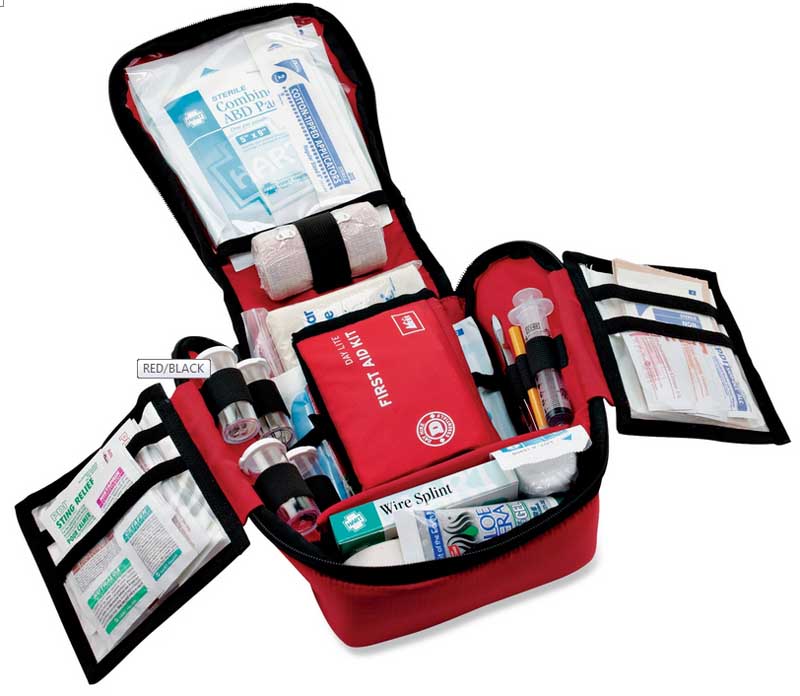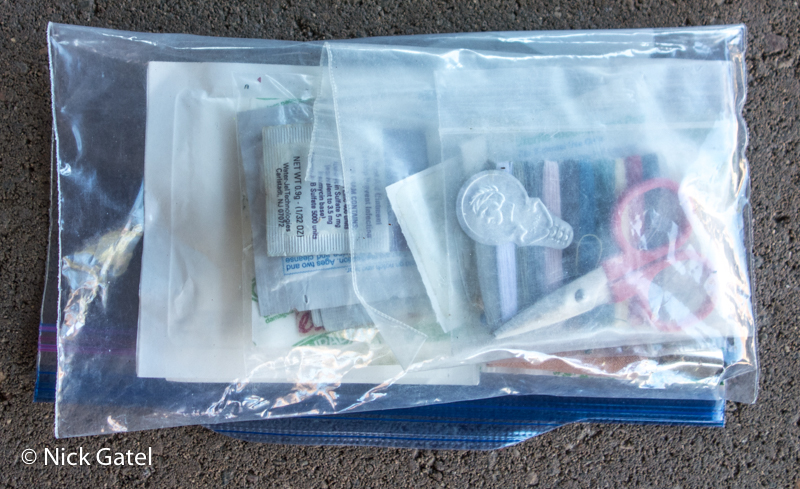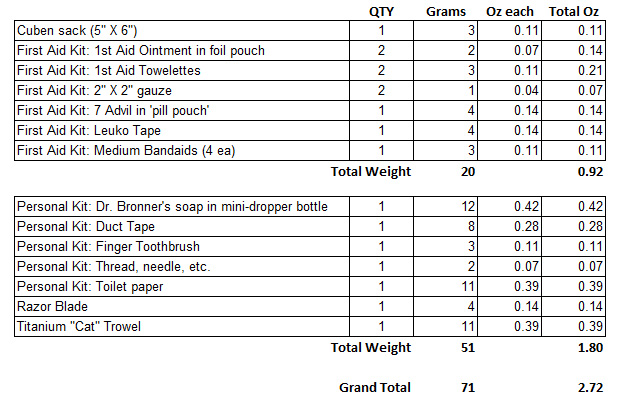
Aside from having fun, the goal of the backpacker on any trip should be focused on staying safe — that is staying dry, warm, avoiding injury, or becoming lost.
Keep in mind that I am presenting my opinions, have been backpacking for nearly 50 years, and almost always hike solo. Many risk avoidance backpackers will be critical of this small kit.
INJURY AVOIDANCE
This is the highest priority. Unless you are a dare-devilish thrill seeker, always analyze your immediate environment to ensure a low probability of injury. This cannot be entirely taught, but requires experience. Over time the backpacker develops the skill to remain safe. The lightweight backpacker will be in the best position to avoid physical injury because light gear allows him or her to be better balanced and agile on the trail. However, if the gear and equipment is too light by not taking the appropriate items to remain warm and dry the backpacker may put themselves in jeopardy. Along with hiking skills, the hiker needs to know what gear and equipment is critical for a successful trip.
PHYSICAL CONDITION
If you accept my opinion that the lightweight backpacker is less likely to get injured because they have better agility and balance, then you need to look at your body and conditioning before hiking. There is no good reason to analyze and reduce backpack weight if you are physically overweight. Getting yourself to a proper body weight costs nothing. If you start out overweight, adding a backpack only increases your chance of injury. On most of my trips my total weight of gear, food, water, and food is under 20 lbs, and around 35 lbs on a few extended trips. If you are 20 or more lbs overweight you are starting out with too much total weight, and increase your chances of injury.
What is overweight? Although not perfect, the Body Mass Index (BMI) chart below is applicable to most people, unless you are elderly or very muscular. The backpacker should shoot for a weight at the lower end of the “healthy” scale. Chart copied from the website of the American Institute for Cancer Research (AICR): BMI Calculator page. If you are overweight, don’t go backpacking. You have a higher chance of getting injured. Why would a hiker fret over gear selection, when they are already at higher risk for injury by being overweight.
GETTING INTO HIKING SHAPE
Once you are no longer overweight, you are not ready to go hiking until your muscles are in shape. If you have not conditioned yourself for a hike with a backpack, you will tire easily, lose focus, become more susceptible to falls and sprains. Get into shape before you undertake a backpacking trip. The best way to get into hiking shape is to hike. Load up your back and go for day hikes several times a week. On the weekends do hikes that are the same distance you will average per day on your backpacking trip.
NOT GETTING LOST
If you cannot navigate with a map and compass, you do not belong in the wilderness.
If you want to bring a GPS unit or smart phone for navigation, that is okay. But they do fail in the field and batteries go dead, so bring your map and compass as backup. Using map and compass requires education and lots of practice. Buy a book or take a class. But don’t leave home without the skill and equipment.
SIGNALING DEVICES
Signal Mirror: First of all, you need to practice using one. You will need to know how to direct the reflection exactly where you want it to go. It is not as easy as one might think. In addition the rescuer must be looking for you and know pretty much exactly where you are. Aircraft must be very close to your location. So for all practical purposes, a mirror isn’t a good solution.
Signal Fire or Flare: A signal fire or flare is better for attracting aircraft, but usually not practical or legal in many areas.
Whistles: might work if rescuers are close by. Normally the rescuers need to know you are lost, and they need to be close by to hear your whistle. A few years ago I started bringing a Fox 40 whistle. But I am not going to rely on it to actually get me rescued. Where it might help is if I am alone and get too injured to travel and the rescuers know where I should be. Although I leave a detailed itinerary with my wife, I often break the safety rules by taking side trips that are not on my itinerary. Some folks say this is dangerous, but I find giving myself the leeway of exploring interesting places is liberating. The enjoyment exceeds the perceived risk.
Cell Phones: Don’t count on a cell phone. They break, batteries go dead, or you lose cell coverage. Losing cell coverage is the ideal scenario — it means you are getting away from civilization and deeper into the wilderness.
SPOT Devices and Personal Locator Beacons: send distress signals via satellite — but suffer the problems of electronic technology; breakage, dead batteries, technical problems by the communication center, or stray electrons.
I prefer to leave the technology at home, it diminishes the wilderness experience.
Heck, in the 19th century John Muir hiked most of California’s mountains, hiked in Alaska, and walked from Indiana to Florida with no technology. Skill always trumps technology.
FIRE STARTERS
Many backpackers bring tinder, fire steel, back up lighters, emergency matches, large knives, axes, and similar equipment. None of them will do you any good if you don’t know how to use them and have no experience with them. Usually I bring a mini BIC lighter and a book of matches. Sometimes I bring a spare mini BIC. In winter I might bring a few waterproof matches. Although I can build a fire in just about any condition, I have never needed to make a fire to stay warm or dry.
FIRST AID KITS
Many hikers buy pre-packaged kits with all kinds of stuff they may not know how to use, or will never need. If you are skilled, not over weight, and pack light the only first aid you will normally need is treatment of minor scrapes and cuts. For major injuries most can’t treat themselves anyway. Foam pads, bandannas, and other non-medical items in your back can often do double duty in emergencies. Many folks say that these heavy pre-packaged first aid kits give the hiker peace of mind — I would argue they give the hiker a false sense of security.
The exception is one of the small Adventure Medical Kits, which come in a waterproof nylon sack. I bought one as a starting point and then added/subtracted what I need. I also found that I didn’t like not being able to easily see the contents, so I got rid of the nylon sack and put everything into a ZipLoc bag.

MY TYPICAL FIRST AID/EMERGENCY KIT
Easily fits into a 1 quart Ziploc bag or a small sack.
This website may be compensated for linking to other sites for sales of products. As an Amazon Associate I earn a small fee from qualifying purchases at no additional cost to the purchaser.


